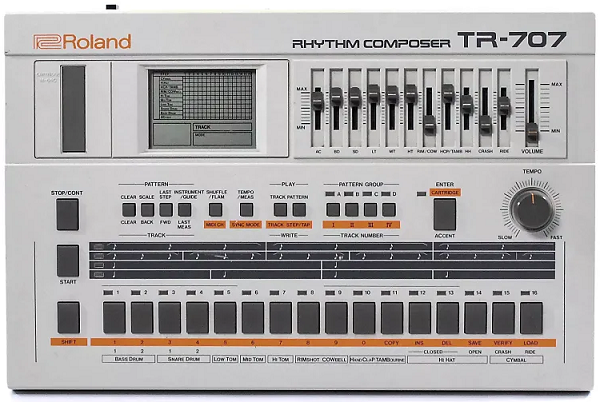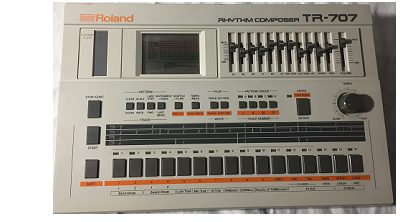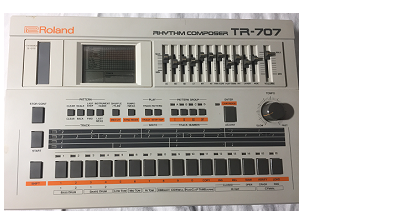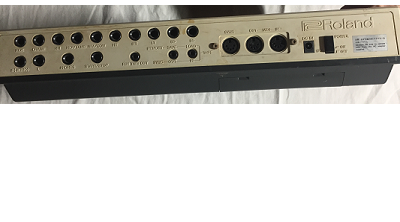Classic Roland Analogue Drum Machine Rhythm Composer
$975.00

Model# TR-707
The Most Underrated Machine in the Rhythm Composer Family
Built with a detailed Matrix display, MIDI in/out, DIN syn capability and individual drum tone outputs, this Rhythm Composer is an overlooked gem of a drum machine featuring 15 digital sounds sampled at 12 bits, 64 programmable patterns that can be sequenced together to form 4 different songs, external synchronization with MIDI and DIN sync, 4 levels of shuffle that operate globally and individual volume sliders for each instrument group. Includes one M-64C Memory Cartridge a $120.00 value also the original power supply and owners manual with quick reference card.
Features:
With fifteen digitally sampled sounds. The instrument is capable of 10-voice polyphony. The alternate bass drum, snare, and hi-hat sounds cannot be triggered simultaneously. The instruments are labeled as Bass Drum, Snare Drum, Low Tom, Mid Tom, Hi Tom, Rimshot, Cowbell, Hand Clap, Tambourine, Hi-Hat (Closed or Open), Cymbal (Crash or Ride), as well as an additional function labeled accent, which serves to rhythmically modify the volume of the other instruments. The instruments are samples of recordings of actual acoustic instruments, and not synthesized individually.
providing four levels of shuffle that operate globally on the rhythm, as well as flam that can be applied to any step. The device offers 64 programmable patterns, which are editable via step-write or tap-write, that can be sequenced together into any of four different tracks. Patterns and tracks can be stored on the device (providing that two AA batteries are inserted) or onto an optional memory cartridge with twice the capacity.
This is particularly sought after by users of Roland gear from the same era because it can synchronize with other hardware via both MIDI and DIN sync, although it cannot do so when controlled by other hardware. There is also an output that allows the Rimshot to trigger hardware that accepts a voltage pulse.
Architecture:
While its primarily a digital device, it still employs some analog circuitry like envelopes and amplifiers.
The sounds where envelope circuits are used to contour the sounds are the Crash and Ride Cymbal, and the Hi-Hats. The Crash and Ride Cymbals are stored and replayed at 6-bit resolution whereas the other sounds are 8-bit samples. This low bit resolution significantly alters the dynamics of the original sounds resulting in very compressed sounds with an unnaturally long sustain. Envelope circuits were used here in an attempt to recreate an approximation the original dynamics of the sounds recorded.
Comparison of the Cymbal samples stored on the ROM and the Cymbal sounds you hear after they have gone through D/A conversion, envelopes, and amplification. These envelopes also play a role in reducing the quantization noise introduced by the low bit-rate used in the circuits, particularly during the decay portion of sounds.
Both the open and closed Hi-Hat sounds are generated by the same sample stored in the ROM. When you trigger the closed Hi-Hat you actually trigger the open Hi-Hat sound that is then enveloped to sound like a short, closed cymbal hit. This approach eliminated the need to store two different Hi-Hat samples on individual EEPROMs. This was a smart and economical move by Roland as digital storage was very expensive at the time, thus allowing them to keep manufacturing costs down.
Legacy:
The TR-707 was a staple in early house music, particularly with acid house. It is also a staple of almost all electronic Arabic pop music. Because it offers a limited number of instruments sampled at 8 bits, its sound is considered dated by modern standards. However, it is still in use because of its versatility in synchronizing with other hardware and its fully featured interface, comparable to that of high-end Roland drum machines such as the TR-808 and TR-909.
Each drum has individual volume sliders and output jacks for each instrument group, which means you can multitrack every single drum into a mixer with ease. Okay, you can’t edit the drum sounds beyond that, but when the hi-hat sounds this good, what is there to change?
With a versatile step sequencing approach common for the Rhythm Composer series, it’s also very intuitive and easy to program.
From the iconic ’80s acid house of Mr Fingers and Marshall Jefferson to the current experimentations of French trio J-Zbel and Canadian hardware duo Minimal Violence, it is still going strong.
Songs that use the 707 include "Need You Tonight" by INXS, ''Move Your Body" by Marshall Jefferson and "Washing Machine" by Mr. Fingers.
Specifications:Used – Very Good
MEMORY CAPACITY: 64 Patterns (4 Pattern Groups x 16)
TEMPO: Quarter Note = 38 to 250
TRACKS: 4 Tracks ( | to |V tracks up to 998 bars)
STEP NUMBER: (Per Bar) ~ 1 to 16 steps
DRUM VOICES: (15 Voices)
· Bass Drums (1 and 2), Snare Drums (1 and 2), Low Tom, Mid Tom, Hi Tom, Rim
· Shot/Cow Bell, Hand Clap/Tambourine, Closed/Open Hi-Hat, Crash Cymbal, Ride
· Cymbal, Total Accent (weaker, stronger)
CONTROLS & INDICATORS: Start Key, Stop Continue Key, Shift Key, Main Keys (1 to 16), Clear Button
IN PATTERN MODE: Scale Button, Last Step Button, Instrument Select / Guide Button
IN TRACK MODE: Back Button, Forward Button, Last Measure Button, Shuffle / Flam Button, Tempo/ Measure Button, Enter Key / Accent Key, Pattern Group Buttons (A, B, C, D)
SHIFT FUNCTION: MIDI Channel Button, Sync Mode Button, Memory Cartridge Key, Track Selector Buttons (| to |V), Pattern Mode Button, Track Mode Button, Tempo Knob,
Accent Level Knob, Bass Drum Level Knob, Snare Drum Level Knob, Low Tom Level Knob, Mid Tom Level Knob, Hi Tom Level Knob, Rim Shot Level Knob/Cow Bell Level Knob,
Hand Clap/Tambourine Level Knob,Hi-Hat Level Knob, Ride/Crash Cymbal Level Knob, Volume Knob,
Display Window – (Rhythm Pattern, Tempo/Measure, Track Number, Mode Sections) Memory Cartridge Slot (for M-64C)
REAR PANEL: Master Output (L, R / Mono)
Multi Outputs: Ten Timber Outputs ~ additional outputs are
· Bass Drum (1 and 2), Snare Drum (1 and 2), Low Tom, Mid Tom, Hi Tom,
· Rim Shot / Cow Bell, Hand Clap / Tambourine, Closed / Open Hi – Hat,
· Crash Cymbal, Ride Cymbal
· MIDI Input
· MIDI Output
· Tape Memory / Sync
· Save / Out, Load / In
· External Control
· Trigger Output (Rim Shot: + 5V, 20ms pulse), Start / Stop (DP – 2),
· Sync In / Out ( 1: Run / Stop, 2: GND, 3: Clock, 5: Continue)
· DC IN (for supplied AC Adaptor)
POWER CONSUMPTION: 2.4 W
DIMENSIONS: 380 (W) x 250 (D) x 73 (H)mm 14 – 15/16" x 9 – 13/16" x 2 – 7/8"
WEIGHT: 1.5kg / 3lb 5oz
ACCESSORIES: 12V AC Adaptor, Connection Cord, Owners Manual, MIDI
OPTIONS: Pedal Switch DP-2, Memory Cartridge M-64C
Same Day Shipping - Ships from Blonds personal stash
Located in: New Orleans, Louisiana, United States
Handling Cost:
$20.00 will be added on items over 30lb
$50.00 will be added on items over 100lb
Free local pickup
Shipping: Calculate
make an offer


